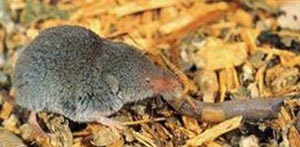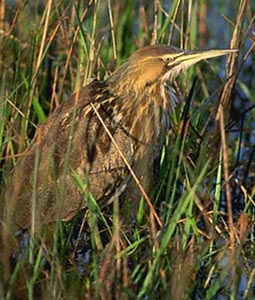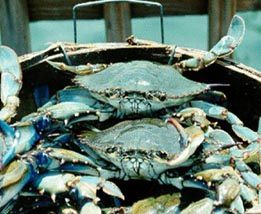What is it?
Tidal marshes are Focus on the Coast's priority coastal resource #1. Tidal marshes include all vegetated wetlands along the coast and along the tidal stretches of our coastal rivers. There are salt, brackish and freshwater tidal marshes. Tidal marshes provide invaluable protected habitat for many juvenile fish species, birds, and other wildlife, help to cleanse polluted water, and protect against storms and floods.
Vegetation
The dominant plant of our coastal salt marshes is Spartina, or cordgrass. Smooth cord-grass (Spartina alterniflora) occurs along the regularly flooded lower margins of the salt marsh, while saltmeadow cordgrass, also known as salt hay (Spartina patens), grows on the higher elevations of the marsh where flooding is irregular. Salt hay is easily recognized by its “cow-licked” appearance in the marsh. Spartina has special glands that enable it to excrete excess salt; an adaptation that well suits it to its coastal environment. Other plants of the salt marsh include black grass, seaside goldenrod and spike grass. In the high marsh, one sometimes finds low-lying areas called “pannes.” Salt water collects in these depressions during high tide and then slowly evaporates creating high salinity levels in the soil. Sea lavender, glasswort, and salt marsh plantain are often found growing in these pannes
Brackish tidal marshes occur where the saline waters of Long Island Sound mix with fresh water from coastal rivers and other sources. Within these areas, one finds many of the same species found in salt marshes such as smooth cord grass but a closer inspection reveals numerous other species as well such as spike-rush and eastern lilaeopsis. Those familiar with these coastal areas know that these brackish marshes are often dominated by tall reed-like plants – either cattails (Typha spp.) or common reed (Phragmites australis). The CT Dept. of Environmental Protection, The Nature Conservancy, Connecticut College, the Natural Resources Conservation Service, U.S. Fish & Wildlife Service, University of Connecticut Cooperative Extension, and numerous land trusts and other groups have worked in many of the marshes along our coast to try to control and monitor the spread of Phragmites australis.
As one moves farther inland along the larger coastal rivers, the marshes are no longer affected by the saline waters of the Sound, but are still influenced by the tides. Freshwater tidal marshes and flats are home to a wide diversity of plants. Cattails, sweetflag, pickerelweed, arrow-arum and bulrushes are just a few of the plants to be found. Stands of wild rice (Zizania aquatica) are most conspicuous in the late fall, and provide food for migratory waterfowl. Snapping turtles, water snakes, numerous mollusks, insects and fish live, feed, and lay eggs in these marshes, the tidal flats and creeks.
Why Are They Important?
These habitats are among the most productive on the planet, providing food, nurseries, resting areas during storms and migrations and homes for a multitude of animals. The marshes serve as a buffer during storm events, help to slow shoreline erosion and act as a filter, absorbing excess nutrients. The marshes provide food, habitat and nursery areas for many fish and shellfish species. Most of our commercially and recreationally important fisheries rely on the productivity of coastal salt marshes. Because salt creates challenges for plant growth, only specialized plants can live in true salt marshes. These natural communities provide, in turn, specialized habitats for unique and often rare species of animals. About 45% of all endangered and threatened species rely on estuarine and coastal waters for survival; many specifically need salt marshes.
What Else Should I Consider?
Tidal marshes are directly subject to state regulation under the Connecticut Coastal Management Act, as opposed to inland wetlands, which are regulated by local commissions.
Climate Change Impacts
The Connecticut shoreline is projected to have a rise in sea level of 20 inches by 2050. This increase in sea level is already impacting our tidal wetlands. As sea level rises there are changes in the high tide level. This rise in water level causes areas within the marshes to be inundated more frequently and for longer periods of time depending on the local elevations. Growth of the marsh vegetation and sediment input often cannot keep up with this relatively rapid rise in water levels, and the marshes migrate landward. However, changes in elevation and infrastructure may make it impossible for substantial landward migration of the marsh and some marshes will be lost due to inundation. Loss of marsh vegetation will in turn lead to loss of ecosystem functions. The ecosystem functions of tidal wetlands include flood storage, wave energy dissipation, filtration of pollutants, wildlife and nursery habitat and carbon storage (peat). Other impacts to this habitat from climate change include changes in soil chemistry, changes in stormwater flow into marshes due to changing precipitation patterns, and the potential for new invasive species.
To better understand how Connecticut’s coastal marshes and roads may respond to sea level rise, Sea Level Affecting Marshes Model (SLAMM) was applied to Connecticut’s shoreline by Warren Pinnacle Consulting, Inc. The results showing marsh migration scenarios and road flooding are available on CT ECO at https://cteco.uconn.edu/projects/slamm/
Links
Long Island Sound Study, Long Island Sound Habitat Restoration Initiative - Visit the Tidal Wetlands Document
|
|
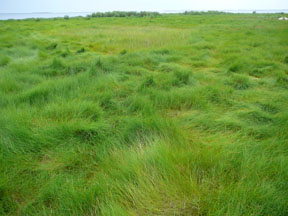
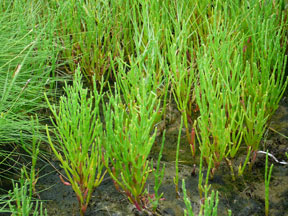
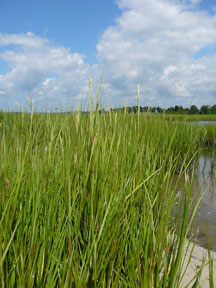
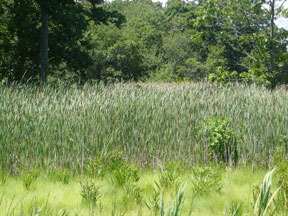

For Citation Purposes: Connecticut Sea Grant & University of Connecticut’s Center for Land Use Education and Research. (October 20, 2016). Tidal Marshes. https://climate.uconn.edu/habitats-resources/coastal/tidal-marshes
